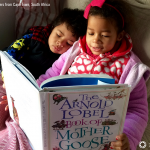
How do we teach our kids to write well without killing their joy in the process? Beware these four myths about teaching writing that can frustrate our kids and keep them from loving to write.
Myth #1: Good readers make good writers.
Truth: Before my fellow book-lovers attack me, let me explain. It is true that reading good books provides our kids with examples of good writing and vocabulary and fuels imagination. Yet simply reading on their own won’t supply the kind of language database kids need to draw from as they write. Why?
A child reading on his own often reads quickly, sometimes skipping words, phrases, and even pages as he skims. He’s still taking in good content, but missing the complete effect.
However, when we read aloud to our children, it forces them to slow down and absorb the more complicated language patterns they might skim over when gobbling up their latest page-turner.
Reading great literature aloud to our children even after they are able to read on their own, is the best thing we can do to help our children develop as writers. We are building a mental storehouse of sound structure, rich vocabulary, and flow of language that will inhabit their own writing.
Unless we fuel our children’s minds with the great rhythms of beautiful language, they are running on empty when they sit down to write.
Myth #2: Be a ruthless grammarian.
Immediately correct grammar and spelling in every creative writing assignment with a heavy hand. Children should learn to avoid lazy writing habits early.
Truth: Nothing squelches the creative process more than coming up with an interesting idea, only to meet the red pen in all its glory. Grammar, punctuation, and spelling have their place, but let’s not nitpick our children’s creative efforts–especially in the early writing stages.
When we give kids a chance to write freely, they are more likely to take chances. We don’t want them to play it safe and use only vocabulary they are sure to spell right on the first try, or write only a few stilted sentences because they are afraid of making mistakes. Set them free! Teach them proofreading and editing skills at another time altogether. Work on grammar separately. Now is their time to learn to brainstorm, organize their thoughts, and communicate.
Myth #3: Handwriting and Writing are the same subject.
Truth: The difference might seem obvious, but think how many young children are forced to labor over long assignments with shaky hands in order to express themselves. Instead, these exercises sap their enthusiasm and push them to think they hate writing long after they have mastered the mechanics of forming letters. Tragedy!
Especially in the early years, it’s important to remember that we can build the kind of brain connections needed for good writing in other ways besides the pencil. Narrating, brainstorming, dictating, storytelling, and playing with words all contribute to the mental process of writing. Handwriting is simply a physical skill to get the words on paper.
Just as our children can benefit from hearing us read aloud from a book that is beyond the level they can read on their own, we can encourage them to compose beyond the level of their handwriting ability.
Myth #4: Writing can be taught only as a formal subject, confined to a desk.
Each lesson must include a dose of drudgery, a strict grading system and significant writer’s cramp.
Truth: You can help your children build composition skills in a variety of surprisingly fun and simple ways. Besides what we think of as formal writing instruction in your language arts curriculum, kids benefit from playing with words and incorporating writing into an overall lifestyle of learning.
Here are a dozen simple ideas to get your creative juices flowing in terms of homeschool writing:
- Write scripts and film your own how-to shows on topics your kids love, from cooking to fort-building.
- Combine art and writing. Highlight things you are learning with illustrations, try making ads or books in a multimedia style, or write and illustrate in a beautiful journal.
- Interview interesting people and write down their stories. Grandparents could share stories of their heritage, a local businesswoman could share how she got started, a fireman could outline a typical day, or a family who recently adopted could trace their journey.
- Write clues for scavenger hunts and involve the neighbors.
- Make up character sketches from photos of interesting people you find online or in magazines.
- Keep a gratitude journal on the kitchen counter and add a line every day.
- Find and correspond with a pen-pal.
- Gather for teatime (or lemonade) to write and illustrate letters for those you know need encouragement.
- Host an open mic night in your home for family and friends. Help kids prepare skits, songs, poetry, or even original jokes to share.
- Write a letter to a favorite author or even a fictional character from a book you just finished.
- Offer your kids inspiration with one of these 100 Non-Boring Writing Prompts or try Diamond Notes to get beyond a blank page.
- Play games that develop some aspect of the writing process. Taboo forces you to think of another way of saying something. Balderdash requires innovative wording, and StoryCubes stretch the imagination. Party games like Never Have I Ever and Two Truths and a Lie develop storytelling skills as well.
If you'd like formal instruction laid out for you, but still want a gentle approach, be sure to check out this updated Language Arts program to get an idea of how Sonlight might help you raise competent communicators who love to learn.









Great read!! Thanks for sharing such a great blog, blog like these will surely help each and every homeschoolers in homeschooling their children in best way.
Love the 12 creative writing ideas! Great resource.
I won't be able to attend this as we have commitments :( Will this be taped or available to watch later? Thank you!
Thanks for your interest, Christine. This Facebook party doesn't contain audio, just chat and resources posted to our newsfeed at http://www.facebook.com/sonlight. You can certainly still scroll through that page and snag some ideas!
Wonderful writing ideas! We're always looking for new and fun ways to encourage writing. Pinned.
Great to hear that you are so actively encouraging your children to write, Joanne!